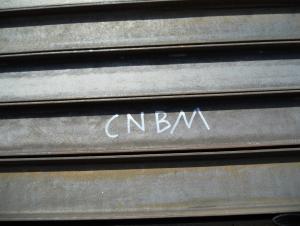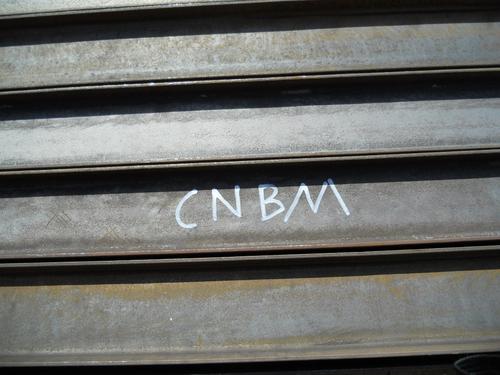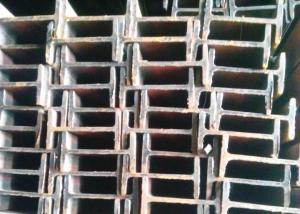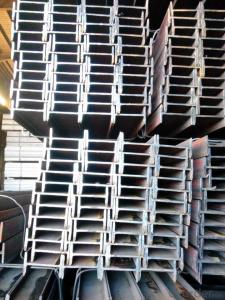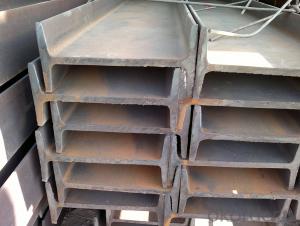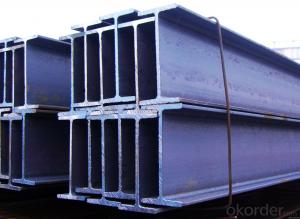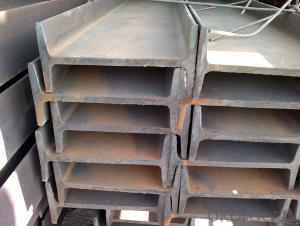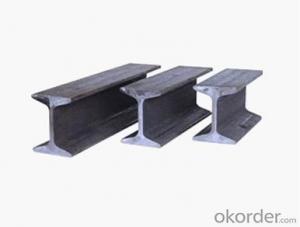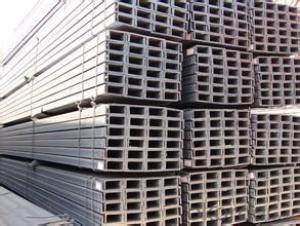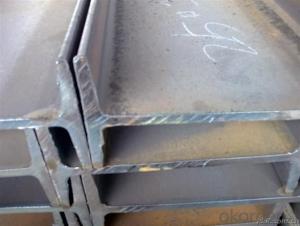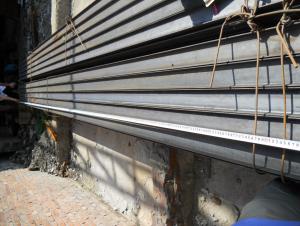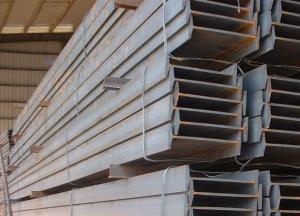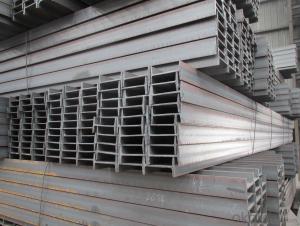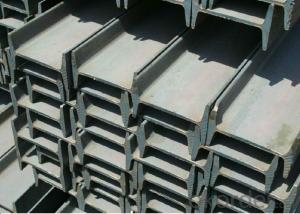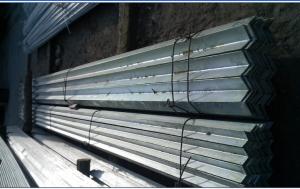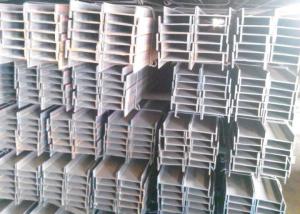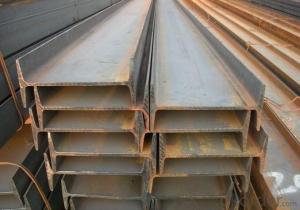HR Steel I Beams with High Quality for Sale
- Loading Port:
- China main port
- Payment Terms:
- TT or LC
- Min Order Qty:
- 25 m.t.
- Supply Capability:
- 100000 m.t./month
OKorder Service Pledge
OKorder Financial Service
You Might Also Like
Product Description:
Production Standard: GB Standard, EN10025, DIN, JIS, etc.
Material of Steel I-Beam: Q235,SS400,A36,ST37-2,S235JR
Length: 5.8M, 6M, 9M, 12M or as the requriements of the clients
Sizes: 80MM-270MM
Section | Standard Sectional Dimensions(mm) | ||||
h | b | s | t | Mass Kg/m | |
IPE80 | 80 | 46 | 3.80 | 5.20 | 6.00 |
IPE100 | 100 | 55 | 4.10 | 5.70 | 8.10 |
IPE120 | 120 | 64 | 4.80 | 6.30 | 10.40 |
IPE140 | 140 | 73 | 4.70 | 6.90 | 12.90 |
IPE160 | 160 | 82 | 5.00 | 7.40 | 15.80 |
IPE180 | 180 | 91 | 5.30 | 8.00 | 18.80 |
IPE200 | 200 | 100 | 5.60 | 8.50 | 22.40 |
IPE220 | 220 | 110 | 5.90 | 9.20 | 26.20 |
IPE240 | 240 | 120 | 6.20 | 9.80 | 30.70 |
IPE270 | 270 | 135 | 6.60 | 10.20 | 36.10 |
IPEAA80 | 80 | 46 | 3.20 | 4.20 | 4.95 |
IPEAA100 | 100 | 55 | 3.60 | 4.50 | 6.72 |
IPEAA120 | 120 | 64 | 3.80 | 4.80 | 8.36 |
IPEAA140 | 140 | 73 | 3.80 | 5.20 | 10.05 |
IPEAA160 | 160 | 82 | 4.00 | 5.60 | 12.31 |
IPEAA180 | 180 | 91 | 4.30 | 6.50 | 15.40 |
IPEAA200 | 200 | 100 | 4.50 | 6.70 | 17.95 |
Usages:
According to the needs of different structures, steel I-beam can compose to different force support component, and also can be the connections between components. They are widely used in various building structures and engineering structures such as roof beams, bridges, transmission towers, hoisting machinery and transport machinery, ships, industrial furnaces, reaction tower, container frame and warehouse etc.
Packaging & Delivery :
1. Packing: it is nude packed in bundles by steel wire rod
2. Bundle weight: not more than 3.5MT for bulk vessel; less than 3 MT for container load
3. Marks:
Color marking: There will be color marking on both end of the bundle for the cargo delivered by bulk vessel. That makes it easily to distinguish at the destination port.
Tag mark: there will be tag mark tied up on the bundles. The information usually including supplier logo and name, product name, made in China, shipping marks and other information request by the customer.
If loading by container the marking is not needed, but we will prepare it as customer request.
4. Transportation: the goods are delivered by truck from mill to loading port, the maximum quantity can be loaded is around 40MTs by each truck. If the order quantity cannot reach the full truck loaded, the transportation cost per ton will be little higher than full load.
5. Delivered by container or bulk vessel
6. Delivery time: All the structural steel I beams will be at the port of the shipment within 45 days after receiving the L/C at sight ot the advance pyment.
7. Payment: L/C at sight; 30% advance payment before production, 70% before shipment by T/T, etc.
Production flow:
Material prepare (billet) —heat up—rough rolling—precision rolling—cooling—packing—storage and transportation
FAQ:
Q1: Why buy Materials & Equipment from OKorder.com?
A1: All products offered byOKorder.com are carefully selected from China's most reliable manufacturing enterprises. Through its ISO certifications, OKorder.com adheres to the highest standards and a commitment to supply chain safety and customer satisfaction.
Q2: How do we guarantee the quality of our products?
A2: We have established an advanced quality management system which conducts strict quality tests at every step, from raw materials to the final product. At the same time, we provide extensive follow-up service assurances as required.
Q3: How soon can we receive the product after purchase?
A3: Within three days of placing an order, we will begin production. The specific shipping date is dependent upon international and government factors, but is typically 7 to 10 workdays.
Images:
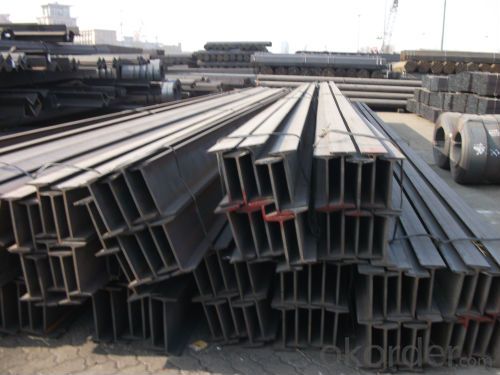
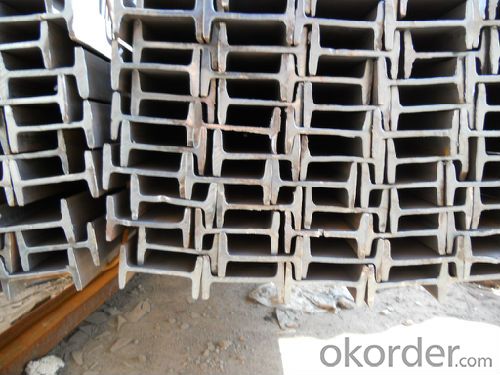
- Q: How are steel I-beams inspected for quality control?
- Steel I-beams are inspected for quality control through a series of visual inspections, dimensional measurements, and non-destructive testing techniques. This may include checking for any visible defects, such as cracks, surface roughness, or uneven welds. Additionally, measurements are taken to ensure the beam's dimensions and tolerances are within the specified range. Non-destructive testing methods, such as ultrasonic testing or magnetic particle inspection, are also employed to detect any internal defects or discontinuities that may affect its structural integrity. Overall, a thorough inspection process is carried out to ensure that steel I-beams meet the required quality standards.
- Q: Welding problems of two I-beam combinations
- Simple words, welding directly at the seams, regular groove, or in the flange to play anchor nails, connect two steel
- Q: Can steel I-beams be used for helipad construction?
- Yes, steel I-beams can be used for helipad construction. Steel I-beams are commonly used in construction due to their strength, durability, and ability to support heavy loads. They can be used as structural components for building the helipad's foundation, support columns, and landing platform, providing a sturdy and reliable structure for helicopters to land and take off safely.
- Q: How long is a ton of 10# I-beam?
- You should be weighed or scale. This I-beam, there is a difference, there is national standard. Weighing 4500 yuan / ton. Generally less, are the ruler, the price of 4100 yuan per ton, and 3700 yuan per ton. Book with material. You take care of market goods. Not material, the price is relatively low.Excuse me, the weight of the 10 I-beam above is 11.261.. I mean the weight of the channel.
- Q: Can steel I-beams be used for retail buildings?
- Yes, steel I-beams can be used for retail buildings. Steel I-beams are commonly used in commercial construction due to their strength, durability, and versatility. They provide the necessary structural support for large open spaces, allowing for flexible layouts and maximizing usable floor space. Steel I-beams can withstand heavy loads and are resistant to fire, making them ideal for retail buildings where there may be a need for large display areas, storage, or even multiple floors. Additionally, steel is a sustainable and eco-friendly material, which can be appealing for retail businesses that prioritize sustainability in their design and construction choices.
- Q: What angles, angles and channels are used in general? Please try to be specific
- Profiles are commonly used in construction for steel structures, plant buildings (single deck, multiple), adding (inserting) layers, and simple and independent components: Roofing frames, interior and exterior steel staircases, etc.In steel construction plants (buildings), what you call those profiles are useful
- Q: What are the common methods of protecting steel I-beams from fire damage?
- To safeguard steel I-beams against fire damage, there are multiple conventional approaches available. 1. Fire-resistant coatings: Applying fire-resistant coatings to the exterior of steel I-beams ranks among the most widely employed techniques. These coatings are designed to form a protective layer capable of enduring high temperatures, thereby preventing the steel from reaching its critical temperature. Fire-resistant coatings can be either intumescent, which expand upon exposure to heat, or ablative, which create a charred layer to insulate the steel. 2. Fireproofing materials: Another method involves enveloping the steel I-beams with fireproofing materials like concrete or gypsum board. These materials function as barriers, impeding heat from reaching the steel and preserving its structural integrity during a fire. Fireproofing materials can be applied as a spray or in the form of pre-formed boards. 3. Fire-resistant insulation: A common approach is to insulate the surrounding areas of steel I-beams with fire-resistant materials. These insulation materials, such as mineral wool or ceramic fiber, aid in reducing heat transmission and safeguarding the steel against fire damage. This method proves particularly useful in situations where there is limited space to directly apply coatings or fireproofing materials onto the beams. 4. Structural protection: In certain cases, the structural design of a building may incorporate supplementary measures to protect steel I-beams from fire damage. This can entail using fire-resistant partitions or barriers to compartmentalize the building, thus restricting the fire's spread and shielding the beams in affected areas. It is crucial to acknowledge that the choice of protection method depends on various factors, including fire rating requirements, building codes, and the specific application of the steel I-beams. It is advisable to consult with fire protection experts or engineers to determine the most suitable method for each unique situation.
- Q: How do steel I-beams handle differential settlement in the foundation?
- Due to their strength and durability, steel I-beams are widely utilized in construction. They are a favored choice when it comes to managing differential settlement in the foundation. Differential settlement refers to the uneven sinking or shifting of a building's foundation. This occurs when the soil beneath the foundation settles at varying rates, causing one section of the building to sink or shift more than another. Steel I-beams are specifically engineered to evenly distribute the load across the foundation, which helps to alleviate the effects of differential settlement. The I-beam's structure, consisting of flanges and a web, creates a robust and rigid framework capable of effectively handling differential settlement. One way in which steel I-beams address differential settlement is by providing a level and stable support system for the building. These beams are strategically positioned to bear the weight of the structure and transfer it to the foundation, minimizing the impact of any settlement. The strength and stiffness of steel enable the I-beams to maintain their shape and resist bending or deflection, even in the presence of differential settlement. Furthermore, steel I-beams are often combined with other foundation support systems, such as pilings or helical piers, to reinforce the foundation and further mitigate the effects of differential settlement. These support systems can be installed at different depths and locations to counteract the varying settlement rates of the soil. In conclusion, steel I-beams are ideal for managing differential settlement in foundations due to their strength, rigidity, and ability to evenly distribute loads. When properly designed and implemented, they provide a reliable and stable support system for buildings, minimizing the impact of settlement and ensuring long-term structural integrity.
- Q: What are the factors that affect the weight of steel I-beams?
- The weight of steel I-beams is influenced by several factors. Firstly, the size and dimensions of the I-beam play a significant role in determining its weight. The length, height, and width of the beam directly affect its weight. Generally, the longer and larger the beam, the heavier it will be. Secondly, the type and grade of steel used in manufacturing the I-beam affect its weight. Different types of steel, such as carbon steel or alloy steel, have different densities and weight per unit volume. Higher-grade steels usually have greater strength and durability, but they may also be denser, resulting in a heavier beam. Another factor influencing the weight of steel I-beams is the thickness of the web and flanges. The web is the central vertical section of the beam, while the flanges are the horizontal top and bottom sections. Increasing the thickness of the web and flanges can increase the weight of the beam. Furthermore, the presence of additional features, such as holes, notches, or attachments, can also impact the weight of the I-beam. These features can either increase or decrease the weight, depending on their size and location. Lastly, the manufacturing process used to produce the I-beam can affect its weight. Different fabrication methods, such as hot-rolling or cold-forming, can result in variations in weight due to differences in material density and structural integrity. In summary, the size, dimensions, type of steel, thickness of the web and flanges, presence of additional features, and manufacturing process are all factors that can affect the weight of steel I-beams.
- Q: Can Steel I-Beams be used for agricultural buildings?
- Yes, Steel I-Beams can be used for agricultural buildings. They are commonly used in agricultural construction due to their strength, durability, and versatility. Steel I-Beams provide excellent support for large spans, making them suitable for barns, storage sheds, and other agricultural structures that require wide open spaces. Additionally, steel is resistant to pests, rot, and fire, making it a practical choice for agricultural buildings that need to withstand harsh environmental conditions.
Send your message to us
HR Steel I Beams with High Quality for Sale
- Loading Port:
- China main port
- Payment Terms:
- TT or LC
- Min Order Qty:
- 25 m.t.
- Supply Capability:
- 100000 m.t./month
OKorder Service Pledge
OKorder Financial Service
Similar products
Hot products
Hot Searches
Related keywords
